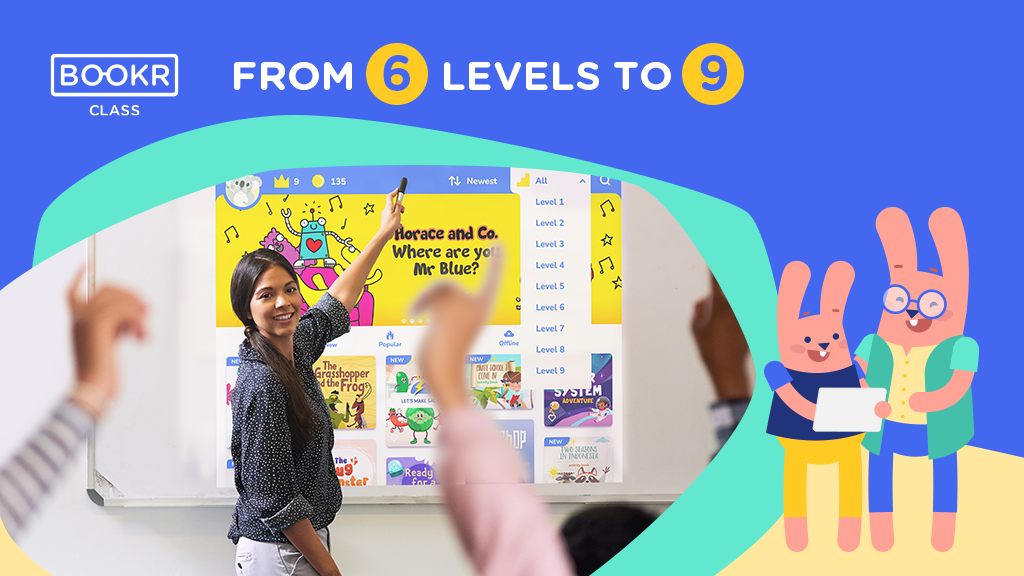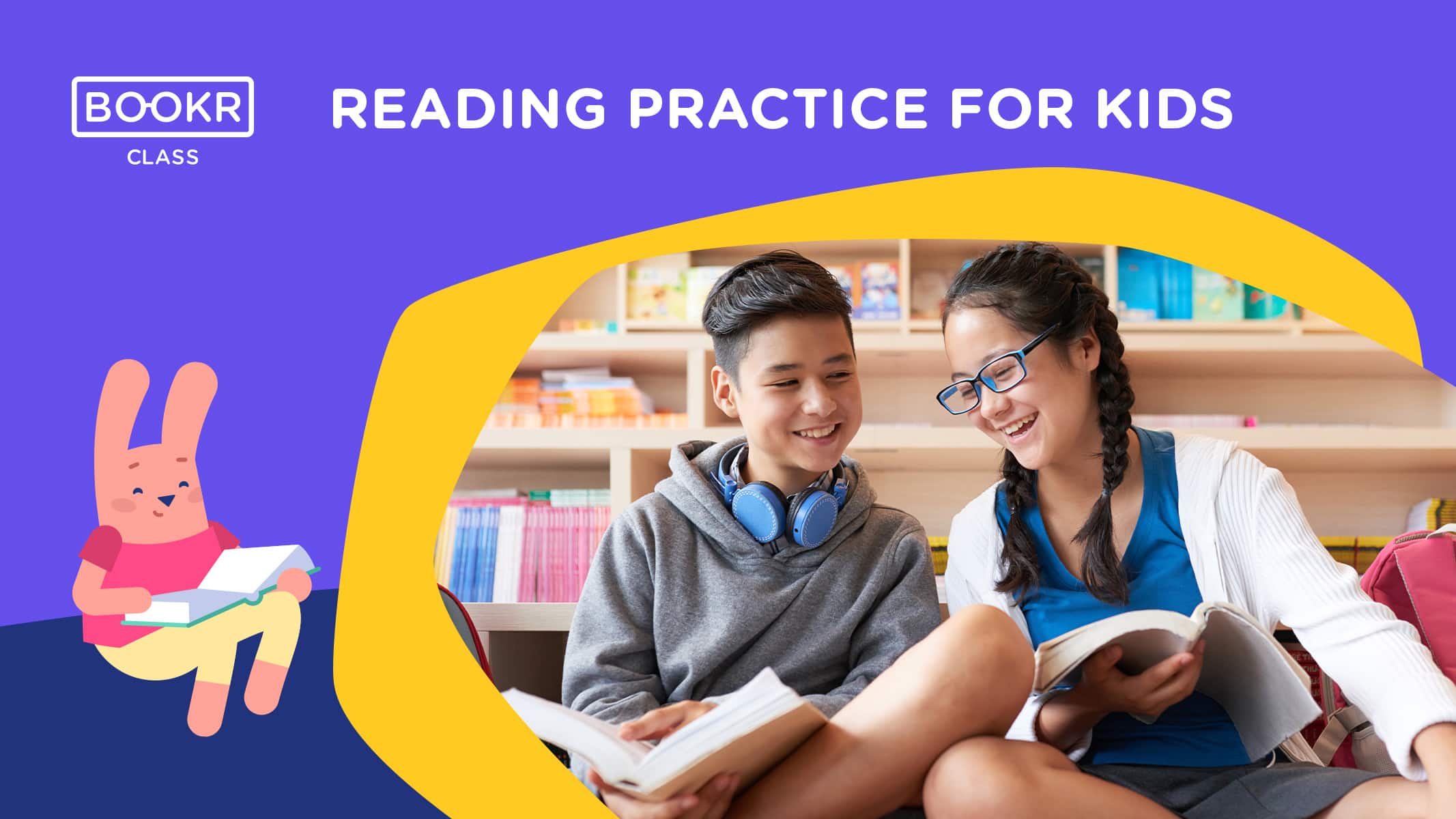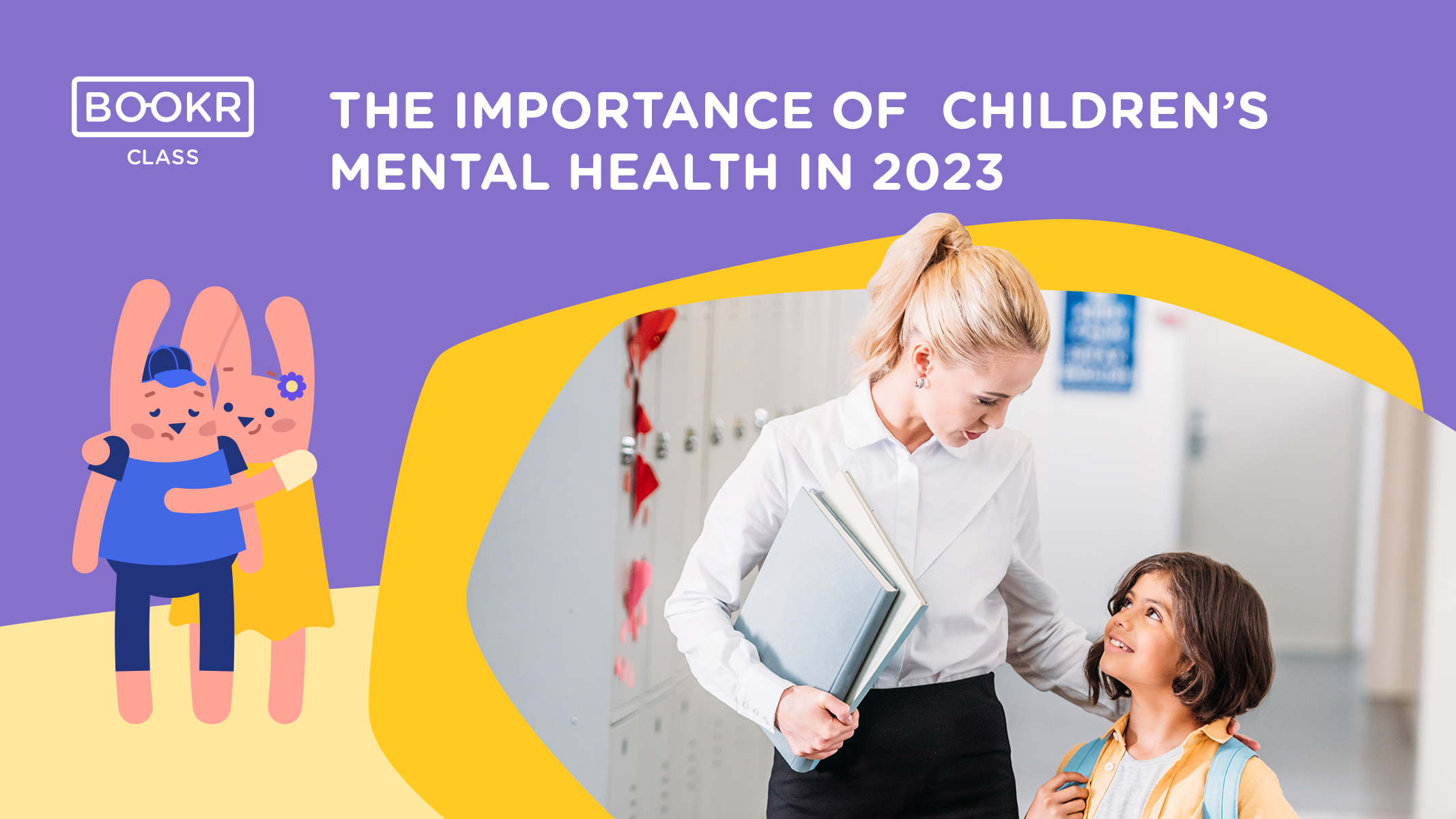The Changing Face of 21st-century Teaching and the Importance of Reading Skills in English
It goes without saying that we live in an excessively digitalised world where our lives are interwoven with technology on almost all levels. More recently, in the wake of the COVID-19 pandemic, we experienced a so-called paradigm shift in education, with online tools and digital solutions becoming more prevalent than their more traditional counterparts.

Table of content
The word ‘traditional’ can refer to both methodology and the materials used in the classroom; and in order to put all these changes in context, this article will focus on the importance of reading skills in English and how this – supposedly – traditional skill can be turned into something ‘cool’ for our digital-native students.
21st-century learning environments
Today, teaching is becoming an ever more complex activity that goes way beyond teaching a subject to students. Consequently, a teacher often assumes a host of roles, depending on the needs of their learners. Most typically, we refer to teachers as educators, agents of change, facilitators (of learning experiences), or even trendy ‘influencers’ at school. In terms of classroom management, the shift from the teacher to a more student-centred view was inevitable as English evolved from a school subject into a life-skill that is best learnt ‘by doing’ (through experimenting and gaining experience).
CLIL (Content and Language Integrated Learning) has been on the agenda of the European Union for about three decades (Marsh, 2002 in Bailey, 2015) and is being recommended as a methodological base among its member states to design language courses.
What makes CLIL extremely powerful is that by mixing language learning with cross-curricular content, we can provide students with a deeper and richer learning experience in real-life contexts.
As a result, a more complex and dynamic language system is likely to develop in the minds of our learners, aided by a richer and better-established vocabulary in both their first language and the chosen target language. The linguistic and intercultural competence they gain, complemented by a host of social, cognitive, and additional ‘soft skills’, are inevitable for achieving success in learning a foreign language as well as in life itself (Thompson & Mckinley, 2018).
When it comes to these so-called soft skills, we must acknowledge the fact that having gone back to school after a prolonged lockdown period, our classrooms have become an even more crucial part of our students’ social life, providing an environment for personal interaction while learning with each other and about one another. Thus, we, teachers, have to take the responsibility to build an interpersonal, flexible, and dynamic community inside our classrooms (Holden & Nobre, 2019).
When it comes to learning resources, creativity ought to be infused with theory and the promotion of after-class learning via various learner autonomy tasks and activities, since in the 21st-century, (language) learning must be taken as a habit that fits into our daily schedules, with educators promoting autonomous learning to all, underpinned by proper pedagogy (Holden & Nobre, 2019).
Choosing our materials wisely is key as it must happen in a way that reflects our students’ interests and everyday (life) experiences (Németh, 2019). It goes without saying that every student is different, so it is highly recommended to conduct needs analysis right at the beginning of your ‘shared career’. Besides language skills, learners can differ in terms of motivation, self-confidence and other factors that impact how they acquire the language. Research has shown that languages are inherently dynamic and so is their representation in our minds. Altering one component of this system will trigger change in all other sections that interact and influence each other (Németh, 2020).
As an added benefit, analysing your students’ needs will help you better capitalise on their strengths, and make differentiation more seamless. In turn, establishing group dynamics for your class will also become less excruciating.
Storytelling in the classroom
To make sure the above listed educational and social needs are satisfied, all we need is a simple yet effective tool that is entertaining and, most importantly, meaningful to the whole classroom community. Believe it or not, storytelling as a methodology seems to be just right.
Stories are an integral part of our lives. As human beings, our communication skills enable us to express ourselves in order to share personal experiences, thus allowing for the greatest narratives one could imagine.
Jumping on this train of thought, it would be almost impossible to ignore stories in the language classroom.
Our mind needs narratives like our body needs food – this is especially true for young children who use stories to discover and understand the world around them. It is a less commonly known fact that children can easily be helped to understand rather complex stories in a foreign language well above their own active command, and as language learners, this is what should first and foremost be expected of them.
Stories can provide a rich source of language input and exposure, all the while being motivating and – comparably – inexpensive. Going beyond motivation, the challenge to subtract the essence of a text will offer countless opportunities for children to awaken a genuine interest and a hunger for learning more (Wright, 1995).
Nonetheless, we should not assume that all the above are enough. Developing language skills can be a time-consuming and challenging process, and may as well require occasional reinforcements to help students find their own voice, gain skills and adopt attitudes in the target language.
Educators play a central role in shaping their students’ self-image, thus an insufficient amount of encouragement may easily lead to a lack of fluency due to confidence issues.
Aristotle once said that “the soul never thinks without an image.” Our imagination can soar when we find ourselves in a safe and welcoming environment that allows students to boldly fabricate and share their stories while freely reflecting on them. As everyone differs in terms of life experiences, you can never tell the exact same story twice – it all depends on how one tells and perceives it (Heathfield, 2014).
There has been a recent resurgence and legitimate interest for story-based approaches to English Language Teaching (ELT), which has created a wider appreciation and a reemerging demand for storytelling in the classroom as a teaching strategy.
A new era: Educational Technology
In order to comply with the changes brought along by the 21st century, education is getting more and more technology-oriented, with EdTech companies trying to find the right niche to reach both learners and teachers with solutions to improve the quality of learning. Nevertheless, we must bear in mind that in a classroom setting, technology means nothing without a teacher with a well-structured plan underpinned by pedagogical considerations in order to make learning as meaningful as possible (Lewis, 2017).
Here is a brief list of why digital educational technologies could become the new standard in education: well-tailored digital technologies (1) are interactive, creative, and authentic; (2) can deepen learning in a collaborative and motivational way; (3) provide quick access to the target language and support (digital) literacy; and (4) are more environmentally-friendly than paper-based resources (Lewis, 2017).
Educators, when planning to implement digital technologies, should consider the following questions (Strasser, 2018):
In summary, when implementing technologies, we need to be mindful of their purpose. Slowly transitioning back to this article’s primary focus, there has been a recent surge in digital storytelling tools ranging from an online version of the classic board-game Story Cubes to gamified library applications such as BOOKR Class, – both of which enable educators to enjoy the advantages of storytelling in the classroom.
A practical example: BOOKR Class
Among the arsenal of digital storytelling tools available, BOOKR Class is one that truly stands out. The application’s methodology mainly draws on CLIL and storytelling with a communicative approach of language learning. Available on smartphones, tablets and desktops, the 3-in-1 platform provides a safe, ad-free, and easy-to-use gamified platform with 600+ e-books and 1200+ games and flashcards available for students by the end of the year. This platform is coupled with a teacher’s dashboard for real-time statistics and a desktop app for online or classroom teaching.
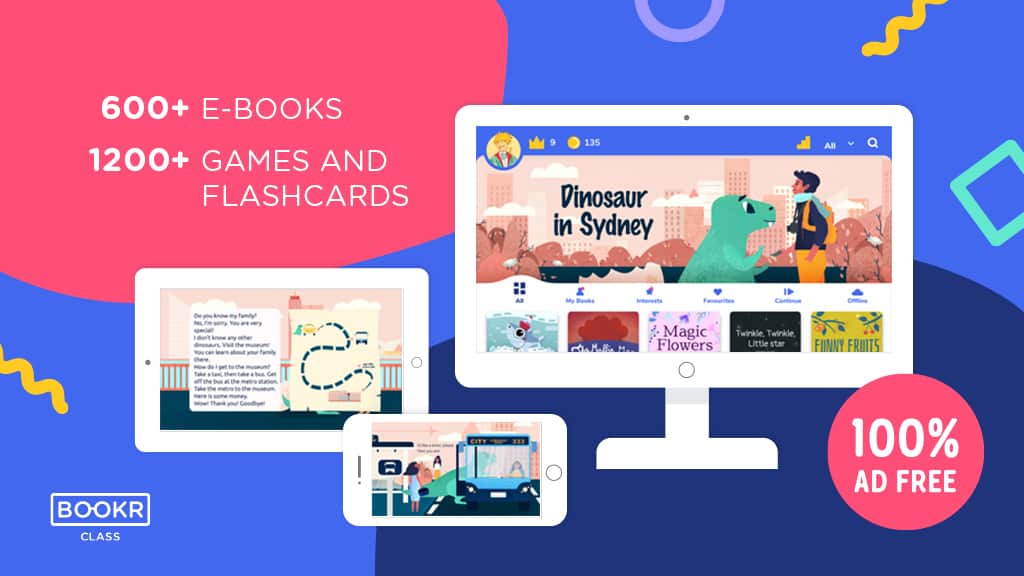
Each storybook provides a complex and immersive learning experience thanks to curated texts, illustrations, animations, interactions, native narration, text-highlighting and educational games.
The content is organised into 6 different levels that correspond to the European Union’s CEFR scale (pre-A1-B2+). With the aim to help you find the appropriate reading level for students, BOOKR Class also uses Lexile placement tests.
The Teacher’s Dashboard allows teachers to recommend books to pupils, assign homework and examine data regarding student performance. Teachers can also browse the Library based on level, age group, grammar or vocabulary, and find complementary materials, such as activity tips, book previews, book statistics, etc.
Future teachers on BOOKR Class
Having conducted a preliminary study with teacher-trainees to gain an insight into their assumptions and attitudes towards EdTech, we collected valuable research data regarding edutainment and BOOKR Class as a digital tool for language learning.
In the table below, trainees’ responses to questions about the app presented according to four key aspects.
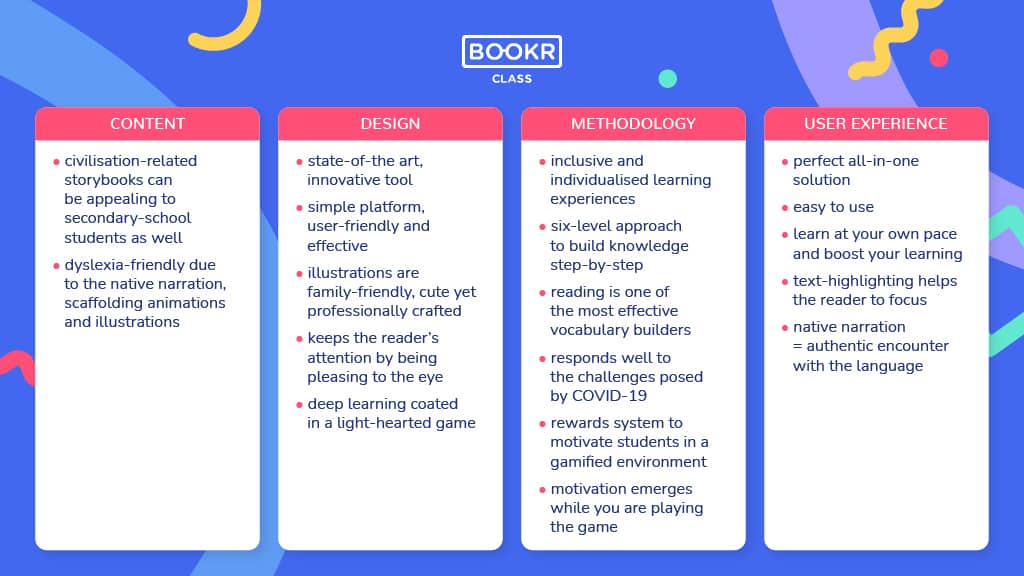
Almost every participant mentioned that learning via an app like BOOKR Class would be less tedious. The consensus was unanimous regarding the question whether the app would have a future in EdTech. As for methodology, they also emphasised the significance of having a Teacher’s Dashboard, which further facilitates individualised learning. As for the design, the friendly-looking illustrations and animations were chosen as the number one feature that also help children visualise and understand the stories.
When it came to user experience, it was made clear that our technologically-oriented children will find this application definitely useful, but it can also serve as an awareness-raising platform for them not to neglect reading as a skill. As for special educational needs, the application tries to find ways for dyslexic readers to make their experience with the application even smoother. For example, apart from being narrated, texts are broken down into shorter chunks for easier processing. On another note, even though the target group is made up of (very) young learners and primary-school pupils, older students may find joy and a relaxing time reading the stories in BOOKR Class.
Final considerations
Summarising the key takeaways of this article, it is clear that the importance of learning a second language is without a doubt. What is more, English has become a basic life-skill that is no longer an advantage but rather a must.
With reference to Lewis’ (2017) claims about digital tools (being interactive, creative and authentic, having the ability to induce deep learning while being highly collaborative and motivational, supporting (digital) literacy, and being environmentally-friendly), should you be considering to begin your EdTech journey today, look no further – BOOKR Class has got you covered on all bases.
